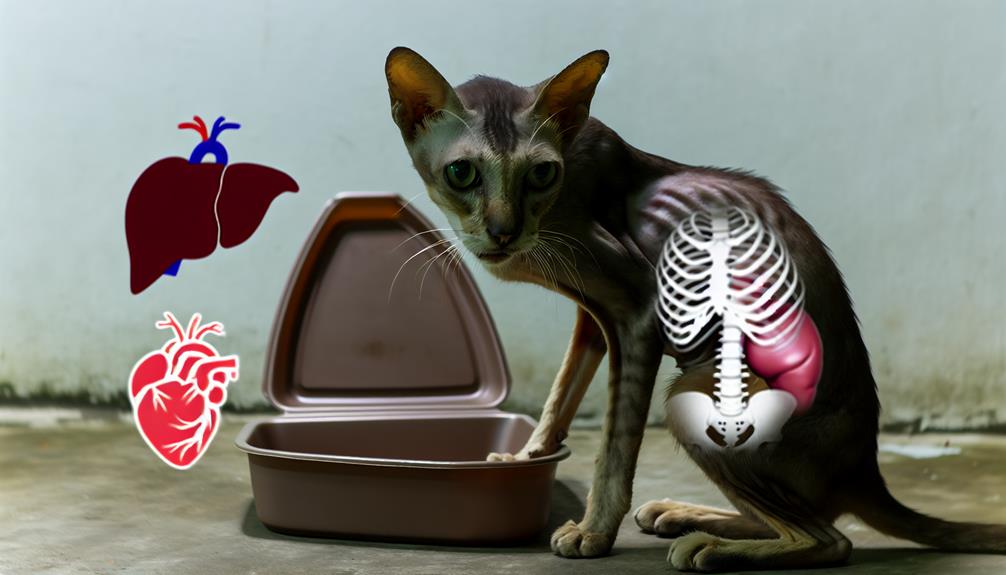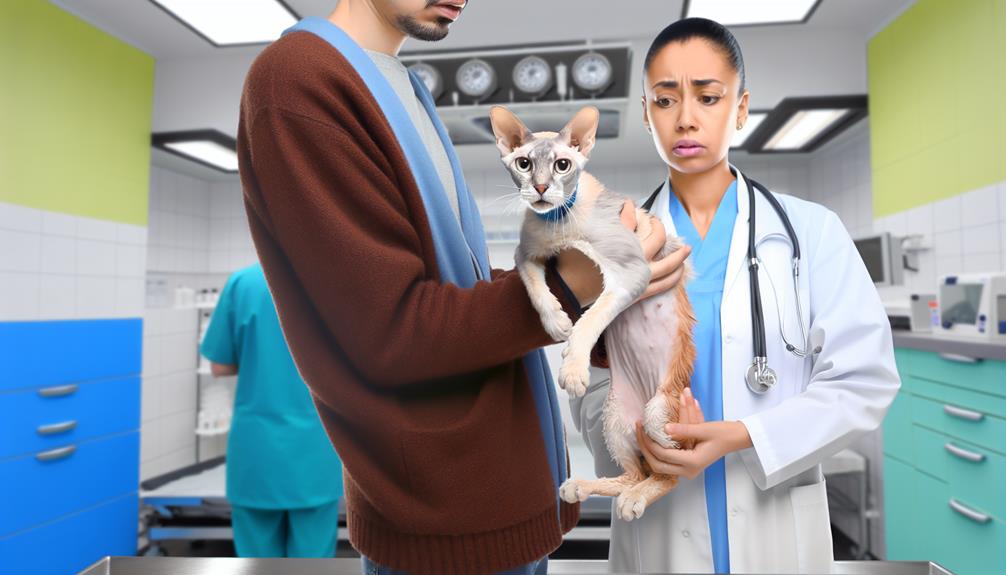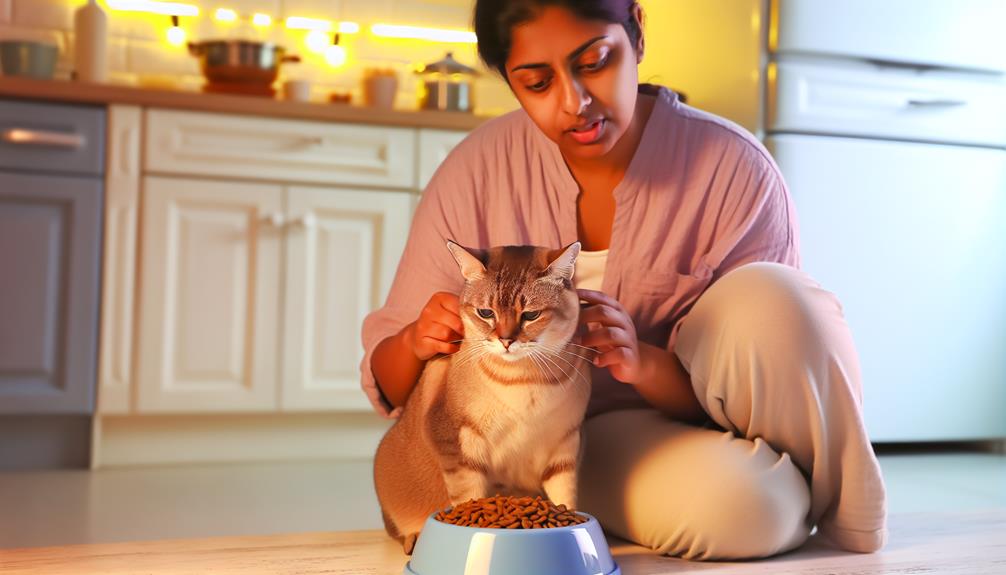You might wonder how long your cat can go without eating before it becomes a concern. Typically, cats can manage without food for 24 to 48 hours, but beyond that, they risk severe health issues like hepatic lipidosis, especially if they're overweight. Understanding why your cat isn't eating is essential, as it can signal underlying health problems that require immediate attention. So, what are the causes behind your cat's sudden loss of appetite, and how can you address them to guarantee your feline friend's well-being?
Typical Fasting Duration
Cats, like many animals, can endure periods of fasting, but it is important to understand the typical fasting duration to guarantee their health. On average, a healthy adult cat can go without food for approximately 24 to 48 hours. This timeframe is based on the cat's physiological resilience and their ability to utilize glycogen stores for energy. However, it is imperative to recognize that cat fasting behaviors vary considerably depending on individual health, age, and underlying conditions.
In a clinical context, a cat's typical eating patterns involve multiple small meals throughout the day, aligning with their natural hunting instincts. Deviation from these patterns can be an early indicator of health issues. While short-term fasting, defined as less than 48 hours without food, might not immediately result in severe health consequences, prolonged fasting can lead to critical conditions such as hepatic lipidosis, particularly in overweight cats. This condition, characterized by fat accumulation in the liver, can be life-threatening and necessitates prompt veterinary intervention.
It is also important to monitor hydration closely, as cats can become dehydrated quickly when they're not eating, exacerbating potential health risks. Ensuring your cat has access to fresh water is just as crucial as monitoring their food intake.
Understanding your cat's typical eating patterns and recognizing deviations can serve as a preventive measure against potential health issues. If you notice your cat hasn't eaten within the 24 to 48-hour window, it is advisable to consult a veterinarian to rule out any underlying health concerns. In sum, while cats can manage short-term fasting, vigilance is key to ensuring their long-term well-being.
Common Causes of Anorexia
Often, feline anorexia stems from a complex interplay of medical, psychological, and environmental factors. Understanding the specific cause can be challenging but is essential for effective intervention. One primary medical cause is gastrointestinal disorders, including pancreatitis and inflammatory bowel disease. These conditions lead to discomfort, discouraging your cat from eating. Dental issues, such as gingivitis or tooth abscesses, can also make eating painful, resulting in reduced food intake.
Psychological stress factors greatly contribute to anorexia in cats. Changes in the household, like the introduction of a new pet or moving to a new home, can cause anxiety and stress, leading to a loss of appetite. Additionally, cats are creatures of habit; any disruption in their routine can trigger anorexia.
Environmental factors, including dietary preferences, play an important role. Cats are notoriously picky eaters, and even minor alterations in their diet can lead to food aversion. Switching brands or flavors without a gradual change can cause your cat to reject their meals altogether.
Here's a concise table summarizing these causes:
| Category | Example Conditions | Impact on Appetite |
|---|---|---|
| Medical | Gastrointestinal disorders | Discomfort, reduced food intake |
| Dental issues | Pain while eating | |
| Psychological | Household changes | Anxiety, stress-induced anorexia |
| Routine disruption | Loss of appetite | |
| Environmental | Dietary changes | Food aversion |
| Dietary preferences | Picky eating habits |
Understanding these common causes helps in pinpointing why your feline friend might be refusing food. Identifying the root cause is the first step towards effective treatment and ensuring your cat's well-being.
Health Risks of Prolonged Fasting

When your cat experiences prolonged fasting, it can lead to serious health complications such as hepatic lipidosis, which is the dangerous accumulation of fat in the liver. Additionally, extended periods without food result in muscle mass catabolism and a weakened immune response, making your cat more susceptible to infections. Monitoring your cat's eating habits is essential to prevent these severe health risks.
Liver Fat Accumulation
A significant health risk of prolonged fasting in cats is hepatic lipidosis, commonly known as liver fat accumulation. When a cat stops eating, its body must find an alternative source of energy. In response, fat stores are mobilized and transported to the liver for conversion into usable energy. However, cats have a limited capacity for fat metabolism, which can overwhelm liver function and lead to the accumulation of fat within liver cells.
Hepatic lipidosis impairs the liver's ability to perform its essential functions, such as detoxification, protein synthesis, and the production of bile. This condition can rapidly escalate, causing liver failure and potentially being fatal if not addressed promptly. Signs of hepatic lipidosis include jaundice (yellowing of the skin and eyes), lethargy, vomiting, and significant weight loss.
Early intervention is vital for managing hepatic lipidosis. Veterinary treatment often involves nutritional support, sometimes necessitating the use of feeding tubes to guarantee adequate caloric intake. Preventing hepatic lipidosis primarily hinges on making certain your cat maintains a consistent and balanced diet. Regular monitoring of your cat's eating habits can help identify and address issues before they escalate into severe health problems. Always consult your veterinarian if your cat shows any signs of decreased appetite or fasting.
Muscle Mass Loss
Your cat's muscle mass can greatly diminish during prolonged fasting, posing serious health risks. When a cat's body is deprived of essential nutrients, it enters a catabolic state where muscle tissue is broken down to meet energy demands. This process impairs muscle preservation and disrupts protein synthesis, which are fundamental for maintaining muscle integrity and overall health.
The catabolic state leads to a significant reduction in lean body mass. Muscle atrophy not only weakens your cat but also affects essential functions such as mobility, respiration, and organ support. Furthermore, muscle loss can exacerbate underlying conditions, making recovery more challenging.
Protein synthesis, the process by which cells build new proteins, is necessary for muscle repair and growth. Without adequate nutrition, protein synthesis is compromised, hindering muscle regeneration. This not only affects muscle mass but also impacts the immune response and wound healing capabilities.
To prevent muscle mass loss, guarantee your cat receives a balanced diet rich in high-quality proteins. Early intervention is critical; consult your veterinarian immediately if your cat shows signs of decreased appetite or muscle wasting. Proper nutritional support is essential for muscle preservation and overall health.
Immune System Decline
In addition to muscle mass loss, prolonged fasting greatly compromises a cat's immune system. When your cat isn't eating, its body lacks essential nutrients required for peak immune function. Nutritional deficiencies can lead to a weakened immune response, making your cat more susceptible to infections and diseases. Proteins, vitamins, and minerals play essential roles in maintaining the integrity of the immune system. Without adequate intake, your cat's ability to produce antibodies and white blood cells diminishes, leaving it vulnerable to pathogens.
During prolonged fasting, the cat's body shifts its metabolic focus to conserve energy, which can further impair immune function. The production of cytokines—key regulators in the immune response—becomes compromised, disrupting the body's ability to combat infections effectively. Additionally, a lack of important antioxidants, such as vitamins E and C, exacerbates oxidative stress, further weakening the immune system.
Prolonged fasting can also lead to a condition called hepatic lipidosis, or fatty liver disease, which severely affects liver function. Since the liver plays a significant role in metabolizing nutrients and detoxifying the body, its impairment further reduces the cat's immune efficiency. Consequently, it's essential to guarantee your cat receives regular, balanced nutrition to maintain a robust immune system.
Signs Your Cat Is Unwell
Noticing subtle changes in your cat's behavior or appearance could indicate underlying health issues. Cats are adept at hiding discomfort, so keen observation is vital. Behavior changes such as lethargy, decreased appetite, or increased aggression can be early indicators. If your cat seems less playful or more reclusive, it's important to pay attention. These alterations might suggest pain, stress, or an underlying illness.
Another significant aspect to monitor is your cat's hydration status. Dehydration can exacerbate existing conditions and lead to severe complications. To check for dehydration, gently pinch the skin between your cat's shoulder blades. In a well-hydrated cat, the skin should return to its original position quickly. If it takes longer, this could be a sign of dehydration. Additionally, examine your cat's gums; they should be moist and pink. Dry, tacky gums may indicate poor hydration.
Physical signs such as weight loss, a dull coat, or changes in grooming habits also warrant attention. Cats that suddenly stop grooming could be experiencing discomfort or illness. Conversely, excessive grooming might indicate skin conditions or stress. Gastrointestinal issues, such as vomiting or diarrhea, are further signals that something may be amiss. Persistent vomiting or diarrhea can lead to dehydration and electrolyte imbalances.
When to Seek Veterinary Help

If your cat hasn't eaten for more than 24 hours, it's critical to seek veterinary assistance immediately. Signs of malnutrition such as lethargy, weight loss, and jaundice can develop rapidly and require prompt medical intervention. Early detection and treatment are essential to prevent severe health complications.
Signs of Malnutrition
Frequently, recognizing the signs of malnutrition in your cat is vital for timely intervention. Nutritional deficiencies can manifest subtly at first, such as through appetite loss. If your cat's food intake decreases considerably, it's essential to monitor for additional symptoms. Look for weight loss, which can be a clear indicator of inadequate nutrient absorption. A dull coat, poor skin condition, and lethargy are also red flags.
In more severe cases, you may notice muscle wasting and weakness. Cats suffering from malnutrition often exhibit gastrointestinal disturbances, including diarrhea or constipation. Anemia is another important symptom, often indicated by pale gums. Behavioral changes, such as increased irritability or depression, can signal that your cat's nutritional needs aren't being met.
If you observe these signs, seek veterinary help immediately. Your vet can perform diagnostic tests, including blood work and urine analysis, to determine the underlying cause. Early intervention can prevent long-term health complications. Remember, malnutrition in cats is not just about food quantity but also quality. Guarantee a balanced diet rich in essential vitamins and minerals to mitigate the risk of nutritional deficiencies.
Critical Time Frames
Understanding the vital time frames for seeking veterinary help can be a matter of life and death for your cat. If your cat hasn't eaten for 24 to 48 hours, it's important to monitor their hunger cues and feeding habits closely. A cat's metabolism can deteriorate rapidly, leading to hepatic lipidosis, a potentially fatal liver condition.
When your cat misses more than one meal, it might signal underlying health issues such as dental problems, gastrointestinal disorders, or systemic illness. If your cat exhibits lethargy, vomiting, or noticeable weight loss, these are red flags indicating the need for immediate veterinary intervention.
It's important to note that young kittens and senior cats are particularly vulnerable. Kittens require consistent nutrient intake for growth, while older cats may have preexisting conditions exacerbated by fasting. A cat refusing food for over 24 hours should prompt a veterinary visit, as early detection of issues like infections, organ failure, or even cancer can be life-saving.
Encouraging Your Cat to Eat
When encouraging your cat to eat, it is essential to understand the underlying causes of their reluctance. Identifying whether the issue stems from medical conditions, environmental stressors, or dietary preferences can guide your approach. Here are some expert strategies to entice your cat back to their food bowl:
- Introduce Tasty Treats: Enhance your cat's meal with high-value treats. Crumbled freeze-dried chicken or fish can make their regular food more appealing. This method leverages your cat's natural predilection for certain flavors and textures.
- Establish Consistent Feeding Routines: Cats thrive on predictability. By feeding your cat at the same times each day, you create a sense of security. This routine helps to regulate their metabolism and reinforces positive eating habits.
- Evaluate Food Presentation: Some cats are finicky about the presentation of their food. Experiment with different types of bowls, plates, or even feeding mats. Additionally, warming the food slightly can enhance its aroma, making it more enticing.
- Consider Environmental Factors: Stress can greatly impact your cat's willingness to eat. Make certain their eating area is quiet, free from loud noises or sudden movements, and away from the litter box. Providing a calm and safe environment can alleviate anxiety and encourage feeding.
Preventing Future Food Avoidance

Preventing future food avoidance in cats necessitates a proactive approach to guarantee long-term dietary consistency. One important strategy involves maintaining a regular feeding routine. Cats thrive on predictability, so establishing consistent meal timing can greatly reduce the likelihood of food refusal.
Varying food texture and flavor variety can also play a significant role in preventing food avoidance. Different textures, such as pate, chunks, or shreds, can cater to your cat's evolving preferences, while rotating flavors helps maintain their interest in meals. Additionally, appetite stimulation can be enhanced by occasionally offering treats or toppers, making the meal more enticing.
Stress factors are another essential consideration. Environmental enrichment, such as interactive toys and scratching posts, can alleviate anxiety, reducing the chances of stress-induced food avoidance. Minimizing sudden changes in the household, such as new pets or rearranging furniture, can also help maintain a stable eating environment.
Health monitoring is indispensable in this situation. Regular veterinary check-ups can pinpoint potential health issues that may contribute to food avoidance, such as dental problems or gastrointestinal discomfort. Early detection and intervention are crucial for maintaining consistent eating habits.
Moreover, controlling meal timing is fundamental. Avoid free-feeding and instead provide meals at specific times each day. This approach not only establishes a routine but also stimulates appetite by creating a sense of anticipation for mealtime.
Conclusion
In conclusion, if your cat hasn't eaten for over 24-48 hours, it's essential to act promptly. For instance, consider Bella, an overweight tabby who stopped eating for three days. Her owner noticed lethargy and sought veterinary help just in time to prevent hepatic lipidosis. Regular monitoring of eating habits and early intervention are important. If your cat shows signs of anorexia, consult a veterinarian immediately to avoid severe health complications. Prevention and vigilance are key to your cat's well-being.
